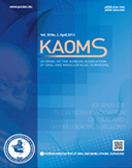Is difficulty of extraction associated with inferior alveolar nerve proximity on computed tomography and increased injury risk?
- 대한구강악안면외과학회
- 대한구강악안면외과학회지
- 제51권 제2호
-
2025.0480 - 86 (7 pages)
-
DOI : 10.5125/jkaoms.2025.51.2.80
- 0

Objectives: Many three-dimensionally-evaluated difficulty indices for impacted third molars have been suggested; however, their radiological and clinical validation according to the inferior alveolar nerve (IAN) remains unknown. This study aimed to evaluate the association of the difficulty index with IAN proximity and injury risk. Materials and Methods: We retrospectively enrolled patients with cone-beam computed tomography (CBCT) for a fully impacted mandibular third molar from January to December 2020. We evaluated the third molar according to the difficulty index based on panoramic x-ray and the nerve index based on CBCT and analyzed postoperative nerve complications. The relationships among nerve proximity, difficulty indices, and nerve complications were evaluated. Data were analyzed using the Pearson’s chi-square test and the Cochran–Armitage test for trends. Results: We included 367 subjects (177 males, 28.9±9.8 years) with follow-up of at least 1 month. Twenty-two subjects had nerve complications. Radiologic evaluation showed that third molars with a high nerve index had an increased difficulty index (P=0.001). Nerve complication risk showed a statistically significant correlation with both nerve and difficulty indices. Conclusion: In conclusion, the difficulty index of an impacted third molar was valid in terms of its spatial relationship with the IAN and in predicting nerve complications.
Ⅰ. Introduction
Ⅱ. Materials and Methods
Ⅲ. Results
Ⅳ. Discussion
Ⅴ. Conclusion
References
(0)
(0)